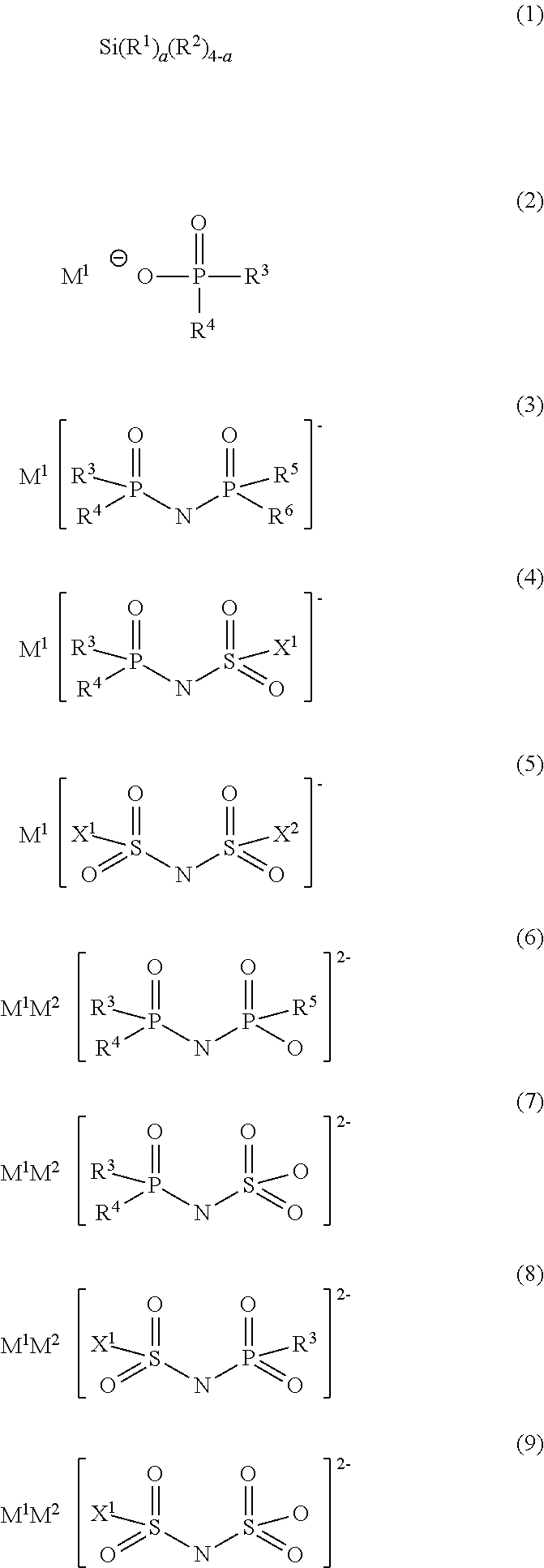Electrolyte solution for non-aqueous electrolyte battery, and non-aqueous electrolyte battery using the same
a technology of electrolyte battery and electrolyte solution, which is applied in the direction of batteries, electrochemical generators, group 5/15 element organic compounds, etc., can solve the problems that none of these batteries has satisfactory properties for use in various applications, and achieve excellent low-temperature output characteristics, excellent cycle characteristics, and high average discharge voltage
- Summary
- Abstract
- Description
- Claims
- Application Information
AI Technical Summary
Benefits of technology
Problems solved by technology
Method used
Image
Examples
example 1-1
[0092]A cell was prepared using the electrolyte solution No.1 as a non-aqueous electrolyte solution, LiNi1 / 3Mn1 / 3CO1 / 3O2 as a positive electrode material, and graphite as a negative electrode material. The cell was actually evaluated for a high-temperature cycle characteristic, a high-temperature storage characteristic, and a low-temperature output characteristic of the battery. A test cell was prepared as follows.
[0093]LiNi1 / 3Mn1 / 3Co1 / 3O2 powder (90% by mass) was mixed with 5% by mass of polyvinylidene fluoride (PVDF) as a binder and 5% by mass of acetylene black as a conductive additive. N-methylpyrrolidone was further added to the mixture and then the resultant mixture was formed into a paste. The paste was applied onto an aluminum foil, and then the foil was dried, thereby preparing a positive electrode body for a test. Graphite powder (90% by mass) was mixed with 10% by mass of PVDF as a binder and then N-methylpyrrolidone was further added the resultant mixture to form a slurr...
examples 1-2 to 1-65
, Comparative Examples 1-1 to 1-64
[0099]In the same manner as in Example 1-1, cells were prepared respectively using the electrolyte solutions Nos.2 to 129 instead of the electrolyte solution No.1 and evaluated for a high-temperature cycle characteristic, high-temperature storage characteristic, and low-temperature output characteristic. Evaluation results are shown in Table 3 and Table 4.
TABLE 1First compoundSecond compoundConcen-Concen-Com-trationCom-trationpound[% bypoundCounter[% byNo.mass]No.cationmass]ElectrolyteNo. 20.5No. 15Li+1.0solutionNo. 1Electrolyte0.50.005solutionNo. 2Electrolyte0.50.05solutionNo. 3Electrolyte0.50.1solutionNo. 4Electrolyte0.50.5solutionNo. 5Electrolyte0.52.0solutionNo. 6Electrolyte0.510.0solutionNo. 7Electrolyte1.01.0solutionNo. 8Electrolyte0.0051.0solutionNo. 9Electrolyte0.051.0solutionNo. 10Electrolyte0.11.0solutionNo. 11Electrolyte2.01.0solutionNo. 12Electrolyte10.01.0solutionNo. 13ElectrolyteNo. 10.51.0solutionNo. 14ElectrolyteNo. 30.51.0solutionNo...
examples 2-1 to 2-43
and Comparative Examples 2-1 to 2-20
[0104]In Examples 2-1 to 2-43 and Comparative examples 2-1 to 2-20, as shown in Table 6, electrolyte solutions for non-aqueous electrolyte batteries were prepared, cells were prepared, and then the batteries were evaluated in the same manner as Example 1-1 except that the kinds of the negative electrode bodies and the kinds of the electrolyte solutions were changed. In this case, in Examples 2-1 to 2-13 and Comparative examples 2-1 to 2-5 wherein the negative electrode active material is Li4Ti5O12, the negative electrode bodies were prepared by mixing 90% by mass of Li4Ti5O12 powder with 5% by mass of PVDF as a binder and 5% by mass of acetylene black as a conductive additive, to which N-methylpyrrolidone was added, applying the thus obtained paste onto a copper foil, and then drying it. The charge end voltage was 2.8 V and the discharge end voltage was 1.5 V, when the batteries were evaluated. Furthermore, in Examples 2-14 to 2-30 and Comparative...
PUM
| Property | Measurement | Unit |
|---|---|---|
| Temperature | aaaaa | aaaaa |
| Temperature | aaaaa | aaaaa |
| Percent by mass | aaaaa | aaaaa |
Abstract
Description
Claims
Application Information
 Login to View More
Login to View More - R&D
- Intellectual Property
- Life Sciences
- Materials
- Tech Scout
- Unparalleled Data Quality
- Higher Quality Content
- 60% Fewer Hallucinations
Browse by: Latest US Patents, China's latest patents, Technical Efficacy Thesaurus, Application Domain, Technology Topic, Popular Technical Reports.
© 2025 PatSnap. All rights reserved.Legal|Privacy policy|Modern Slavery Act Transparency Statement|Sitemap|About US| Contact US: help@patsnap.com



